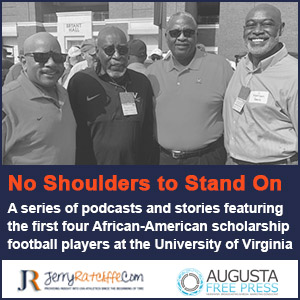Bronco’s Half-Mil Gift Much More Than A Commitment
By Jerry Ratcliffe
(First in a two-part series)

UVA head football coach Bronco Mendenhall poses in his office with the Belk Bowl trophy.
When Bronco Mendenhall and wife Holly stepped up and made the first contribution to a new Virginia football facility, the reaction ranged from surprise to disbelief to astonishment.
The new home for UVA football, which would replace the Frank McCue Center, is only part of the athletic department’s master plan, a $180-million facility for not only football but also the school’s Olympic sports teams.
Someone had to get the ball rolling, and the Mendenhall’s thought, who better than us? They contributed a $500,000 gift, which raised a few eyebrows in Wahoo Nation.
Critics questioned if Bronco was attempting to solidify his future as the Cavaliers’ head football coach, which was nonsense, because his team had posted seven wins and heading to the Belk Bowl where UVA would dominate South Carolina from the SEC and give the program its first bowl win and first eight-win season since 2011.
The Mendenhall’s had discussed the contribution long before the Wahoos were back on the winning track.
When they actually committed to the gift, kicking off the campaign, it took everyone by surprise.
“It really wasn’t the movers and shakers of the university that gave me the initial response, it was my peers,” Mendenhall said. “I would say [other coaches] were dumbfounded in that we all realize the risk and the uncertainty on the tenuous position we are in as coaches, and how quickly and how volitive the position is, and how easily you can be fired or leave a program.”
Mendenhall estimated there was both disbelief and skepticism from the coaching community.
“That was the first striking part of my colleagues wondering why would you do that? If you look matter of factly, there’s merit to that argument.”
University officials were equally surprised. Wait, they’re coming from Utah. None of the Mendenhall’s went to school at UVA. Why would they do this?
AD Carla Williams understood why.
“Bronco is a unique coach,” she said. “He understands the commitment.”
Exactly.
“I’m not able to coach a team or an institution without a commitment beyond just employment,” Mendenhall said. “There has to be something more for me to lead and guide young people authentically. What made perfect sense to me, it didn’t make sense to my colleagues.”
The coaching community shared a belief that any head coach is giving enough of time and what the job requires. They thought what Mendenhall did was not good business. It was the university’s job to help and support the coach, not vice versa.
None of that resonated with Mendenhall’s philosophy, which is contribution based, not entitlement.
As early as their first year in Charlottesville, after the Mendenhall’s had packed up their family, meaning seven assistant coaches and their families (totaling 63 people) and moved all the way from the Rocky Mountains to the Blue Ridge, clear across the country, to take on the challenge of reviving a football program that hardly had a pulse, the thought of a new facility was on Bronco’s mind. He even mentioned that in his very first address when introduced as UVA’s new football coach at John Paul Jones Arena.
“I had talked to Holly about if UVA’s football program was to have success and if we’re going to be able to capture the hearts and minds of not only the players, but this institution and the fans, this can’t be approached as if it’s a job,” Mendenhall said. “This is going to have to be approached as if it’s a mission and it’s a commitment that goes beyond football.”
In Bronco’s world, that means he gives more than what might be expected by a traditional football coach because the circumstances he was confronted with required launching his program from a deficit that was substantial. Virginia had experienced one winning season in the previous seven and had finished higher than sixth place in the seven-team ACC Coastal Division only once (fifth in 2008) during that time span.
As head coach, he believed the leader sets the standard for all parties and it was only appropriate that he give more than time and talent worthy of his hire. There had to be more depth to his commitment. Once Williams was onboard as AD and the master plan became real, Mendenhall said that not only did he and his wife want to help … they wanted to be first in line.
“That is really doubling down on the stakes as to what this really was going to require and necessary for us to building something lasting and sustainable that I think will be beneficial to everyone at UVA and the community at large,” the coach said.
When Mendenhall considered what could be done with not only $100,000, but rather $500,000, he immediately was at peace with his decision. When he says — and he says it often — that he loves his team, the kids on his team, his coaching staff, he means it. He saw the gift as investing in them and their futures.
If he had any lingering doubt at all, that was put to rest immediately after kicking some Gamecock booties in Charlotte. He couldn’t help but notice how happy UVA’s fans and supporters were after that butt-kicking performance.
“What Holly and mine’s contribution does is just give us a better chance, not a perfect chance, but a better chance to do that again.”
Up until the Belk Bowl win, it appeared that UVA supporters were taking a wait-and-see approach toward pouring money into the new football home. Hearts were captured with that victory and Wahoos understood that these coaches, who pulled up stakes at BYU and transplanted in Virginia, weren’t just coming to “win and run.”
Last week, an anonymous donor contributed $5 million ($4 million of that to the master plan, $1 million to the student health and wellness center).
The mood seems to have shifted.
“I think while people were deciding do they want to [contribute], we were playing good enough football and the type of kids we’re recruiting, and how they’re doing academically and socially, and the guiding principles behind the [football] program are starting to resonate,” Mendenhall reasoned. “This is sincere, authentic people trying to develop others through the sport of football, and having success at the same time, which really is the mission of the institution, to develop student leaders.
“I think if you’re a supporter of the University of Virginia, you’re almost by default a supporter of UVA football because they’re aligned the same.”
A new football home is important because the Cavaliers are in an arms race, so to speak. When the ACC expanded from 9 to 12 teams, then to 14, Virginia football didn’t make any much-needed adjustments in football and fell dramatically behind many of its conference rivals. Former coach Al Groh warned of this during his tenure, which ended in 2009, but his pleas fell upon deaf ears. Jon Oliver, a longtime associate AD, admitted that UVA didn’t listen and the football program suffered as a result.
When Williams came onto the scene, she immediately infused more budget, more personnel into the football program, which paid immediate dividends, which has helped Virginia string together back-to-back bowl appearances for the first time since 2005.
The late George Welsh, who put Wahoo football on the map, stated more than a year before his passing, that Virginia was well behind much of the ACC in terms of facilities, i.e. the football building.
When Mendenhall was asked what he would tell those who like his program but don’t understand the importance of the new football home, he didn’t hesitate.
“I would say that I invest in people and I want people to succeed, and when I see things that are necessary — not optional but necessary — for them to reach their potential, I like to eliminate obstacles,” Mendenhall said. “For the University of Virginia football program, the athletics program collectively, this isn’t an optional building, this isn’t an optional plan. This is an essential ingredient for young people’s success in the athletic endeavors they undertake at UVA.”
With University Hall now gone, many of UVA’s sports programs are operating out of trailers.
“If we want exceptional athletics at UVA, which we certainly want academically, and want Virginia to be known for that, then why not give students their best chance in their field of emphasis and interest to have the very best chance at success?” Mendenhall said. “To not do that, to me doesn’t seem morally right.
“Why not give someone their very best chance to excel and reach their goals, dreams and aspirations? Holly and I’s donation is moral in its foundation. We want these kids to have success. We’re investing in something that I think is essential, not optional. I hope others will see the same way.”
Coaches at other institutions have explained in detail to Mendenhall just what a new facility can do for a football program.
Take Northwestern’s Pat Fitzgerald for example. The Wildcats captured their division in the Big Ten this past season and played for the conference championship. The school, which had largely skimped on its football program until Fitzgerald’s arrival and his commitment to stay rather than go for a more attractive job at a powerhouse, invested in one of the most glorious football homes imaginable.
Virginia has no such plans. Williams has insisted on while UVA’s facility will be state-of-the-art and a great building, it will not be adorned with frills such as Clemson’s putt-putt addition or adult slide in the building. It will be efficient and practical.
“You don’t have enough time to hear from [Fitzgerald] what their facility has done for their program,” Mendenhall said. “You ask the question and then you better have all day.”
Efficiency, effectiveness, and opportunity to accelerate and advance Northwestern’s football program is something the Wildcats’ coach loves to talk about.
“The kids’ perspective of what they’re doing matters, and also the efficiency, because we’re all racing against the clock,” Mendenhall pointed out. “How they’ve lined up the teaching effectiveness, their transitions, the quality of care for their strength, rehab, recovery. They are now better than what they were, which gives them a more likely chance to compete.
“More importantly, [Northwestern’s] building itself is a symbol of excellence. When people see it, it’s ‘Wow, now this is impressive, this really matters.’ They’ve invested a lot in these kids. Not in football, in these kids. To me, it’s the same as an engineering building, an architecture building or business building. It’s, ‘Wow, they’re investing in these young people and it matters.’”
Mendenhall has talked to coaches at numerous institutions and he gets the same feedback. Those new football centers, football homes, have an instant intangible effect.
Northwestern is perhaps the best model that Virginia can relate to simply because it’s a strong academic school that has struggled in football for a very long time. Now, it has a motivated, sincere, authentic coach tied to principle and is getting the alumni and fan support.
“Can you imagine if we stay on the same trajectory we’re on through three years?” Mendenhall said. “And that aligns with the completion of a new facility. There’s a magnifying effect and a compounding interest and a most visible ambassadorship of the institution’s brand, morals, values, ethics and beliefs.
“What if the program is aligned exactly with the institution on those qualities, not separate from? What if the football program is after the exact same ideals as the institution? What if those are embedded in the guiding principles and being taught? How then does that not make sense to support and get behind the program? That’s what myself and our staff has really tried to do, design a program specific to UVA and what Virginia holds most dear, so that when we play it represents those things.”
Mendenhall believes that the Commonwealth, the City of Charlottesville, UVA alum would gladly want to be part of that success.
COMING FRIDAY: Part 2. Mendenhall reflects on the Belk Bowl domination of South Carolina and what other rising program in the nation he compares Virginia with, plus Year 4 expectations, Bryce Perkins, and more.








